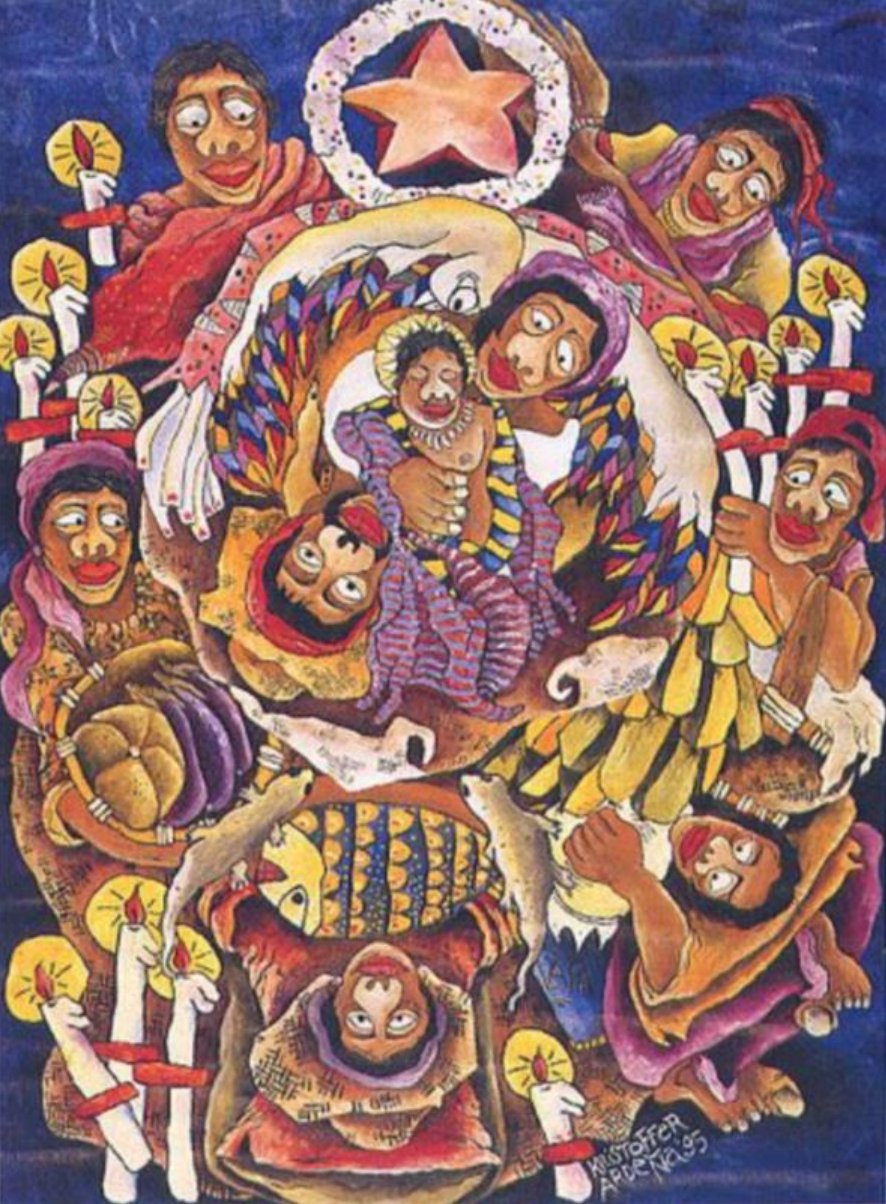The Art of Advent: Day Seventeen
By Mary Whitlock
Today, on the third and penultimate Sunday of Advent, and for our 17th Art of Advent, I would like to reflect a little on the universality of the Nativity – the ‘true meaning of Christmas’, if you will.
Many of us are accustomed to images of the Nativity involving Mary, Joseph and Jesus, along with a couple of shepherds and perhaps three Kings. They are invariably set in a stable, framed by angels and portrayed as white European figures. Such was the (largely Italian) pictorial tradition of the coming of Christ for centuries, from Giotto to Barocci, Caravaggio to Giorgione.
Whilst the Western iconographical history of these scenes is interesting to study, works further afield geographically, though perhaps closer temporally, are what interest me here.
Erland Sibuea, Nativity, 2008. Acrylic on canvas, 31 x 23.6 cm.
In Nativity by the Indonesian artist Erland Sibuea, the ox and hay bales have been discarded in favour of a less didactic swirl of powerful flora and fauna. In this 21st century depiction, the natural world, in all its colourful splendour, rushes to embrace the child, with looks of awe and bewilderment on the bodiless figures’ faces. As such, all of creation rejoices in the birth of the saviour, Jesus Christ.
Kristoffer Ardena, The Meaning of Christmas, 1995. Oil on canvas, 62 x 46 cm.
In The Meaning of Christmas by Kristoffer Ardena from the Philippines, the circular motions are furthered, with the artist preferring to paint on the floor, turning the canvas as he works. Though some traditional iconography is used, such as the light of the candles, it is the rhythm of the circular layers of the composition, combined with the wide-eyed gazes of all of the figures looking inward to the child, that is most powerful. The all-encompassing nature of God’s love is represented most keenly here.
Some may argue that these artists have represented the Nativity ‘inaccurately’. But, ultimately, we do not know what Mary, Joseph, or Jesus looked like. These artists create more contemporary, at once more personal and more universal interpretations, of a traditionally exclusionary scene.
Not only are European features discarded but the deeper, perhaps more abstract, messages of love and hope (that ultimately transcend cultural and geographically specificities) are reflected. Whilst there is power in different cultures having their own ‘version’ of Jesus, realising that God’s message goes beyond these differences has equal, if not more, relevance for visual depictions of the Nativity scene. For the angel did say to the shepherds, “Behold, I bring you tidings of great joy, which shall be to all [my emphasis] the people.”
Bibliography
Blyth, Caroline. “Advent Offering 23 December”. Auckland Theology and Religious Studies. 23rd December 2014. Accessed 16th December 2023. https://aucklandtheology.wordpress.com/2014/12/23/advent-offering-23-december-2/
Conner, Louise. “The Art of Creation”. The Ecological Disciple. 22 December 2022. Accessed 16th December 2023. https://www.ecodisciple.com/blog/expansive-love/
Finney, Dorothy. “The 12 Days of Christmas: 12 wonderful and inspiring art interpretations of the Nativity from around the world”. Tran + Thomas Design Studio. 6th December 2018. Accessed 16th December 2023. https://tranthomasdesign.com/the-12-days-of-christmas-12-wonderful-and-inspiring-artinterpretations-of-the-nativity-from-around-the-world/
Hildegard. “Jesus for All Peoples”. Island Life – In a Monastery. 24th December 2016. Accessed 16th December 2023. https://islandlife-inamonastery.blogspot.com/2016/12/jesus-born-for-all-peoples.html
Jones, Victoria. “Nativity Paintings from around the World”. The Jesus Question. 25th December 2011. Accessed 16th December 2023. https://thejesusquestion.org/2011/12/25/nativity-paintings-from-around-the-world/


